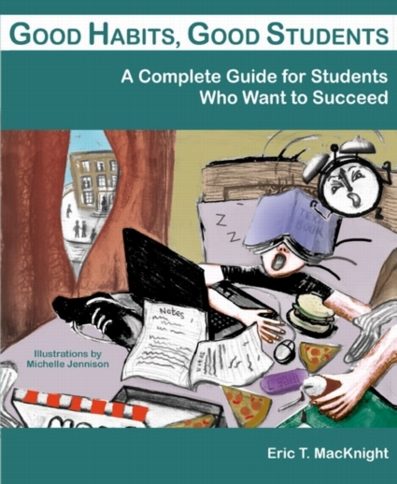[Konrad Glogowski teaches middle school in Canada and authors the excellent Blog of Proximal Development.]
I believe that one of the greatest strengths of this book is that it addresses the whole person, not just the academic life of a young person. The very first page, Good Habits at a Glance, lists personal habits which I think helps young people understand that good habits are not just about doing homework or preparing for tests but also about being a good person.
The opening story about a genie is a great touch. I know for a fact that most of my students would choose being a genius, a student who can easily find inspiration and come up with brilliant ideas. Your story makes it easy for young learners to grasp that academic success and success in life, for that matter, are not about innate brilliance but about solid preparation and good habits. So, before I even started looking at the table of contents, I knew that your book had much to offer, primarily because it helps students understand that anyone can experience success, that what we consider an elusive goal of academic success is not limited to those of their peers who happen to be born readers or problem-solvers. In other words, this is a book that empowers and it does so in its first two pages. No wonder I kept reading!
Another strength is that the book demythologizes the art of good habits and makes it easy for anyone to become a good planner and a responsible student who understands the importance of good habits. The section that invites readers to test their personal, work, and study habits helps students gain self-knowledge and decipher the seemingly complicated question of what it means to be productive, organized, and reliable. This is a very important part of the book, one that I immediately thought of using with my middle school students at the beginning of the school year! Helping students understand who they are first before charting their own path to improvement is a very effective strategy that they can adopt at any stage in their academic career. It is also a strategy that does not just point out weaknesses and the desired goals but that also helps students draft a plan of action, thus putting them in charge of their own lives and the path to improvement. You make this process easy to understand and apply.
I also applaud the idea to encourage students to critically read their own report cards. One of my colleagues makes that a class activity after every reporting period. She gives students copies of their report cards and has them read the comments carefully and then formulate a plan or a set of goals, even if the report is absolutely glowing. Your section on report cards made me think of her approach. I know how effective and empowering it can be and am thinking of using it myself. Of course, you encourage students to do that on their own, which is an important skill to master and a very important habit to have. The steps that you outline can help students take appropriate action after receiving their report cards. They make it easy to learn from one’s experiences and from feedback offered by teachers. The most valuable part of this section, in my opinion, is the fact that it encourages students to read the comments and not just look at the grades. This helps them understand the rationale for those grades, it helps them decode what makes them a B- student, for example, and the steps they can take to change that. Needless to say, this is a very valuable section.
Another wonderful and practical feature of the book is that it gives students templates that they can use to set a goal. Students can easily develop strong personal and work habits not just by reading detailed advice but also by becoming actively involved in the process of improving their own habits by using the “Set a goal!” templates included in these sections. I know many students who could use these templates as they are, without any modifications, and succeed as learners. But the strength of this addition to your book is that the eight parts of each template – Goal, Action required, How often?, Start date, Monitoring, Time limit, Measure of success, and Revision – can be easily adapted to any task. They also help students see that becoming organized and learning to plan and monitor one’s progress is not something that one has to be born with, but something that one can easily accomplish with just a bit of effort. You make the process transparent and easy to follow and adapt to any situation – that’s quite an accomplishment!
In short, this is not a book that talks down to the students or just outlines the goals and the right habits – that, after all, is the kind of nagging that they are exposed to regularly and which does little to help them improve or even understand their habits or practices. Instead, the book is a guide that makes it easy for young people to take control of their habits and chart their own path to improvement. It is definitely the kind of resource that I would like to have at my disposal as a middle school teacher.

